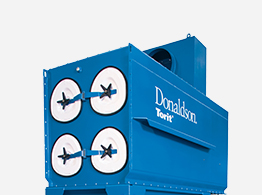Dust collectors are essential at any workplace that generates dust such as woodworking, metalworking, manufacturing, food, pharmaceutical and many other industrial facilities. Inadequate dust control can impact the environment within your facility, resulting in poor employee performance and reduced productivity. Implementing the right dust collection technology will help to keep your workplace clean and productive.
There are a few factors to consider when determining the correct style and size dust collector for your needs:
- The type and volume of dust generated
- Airflow or CFM required for the specific process
- Environment and Location (also inside/outside if needed for venting/NFPA requirements or outside if it doesn’t fit in the facility)
Select the Collector Type or Style
Identify the types of dust and/or fumes generated in your facility. Consider the dust characteristics (moisture, temperature, shape of particles, and chemical makeup). This will help you to determine the type of dust collector that you need (cartridge, baghouse or fluted technology). Please note that there is usually more than one option for the “type” of collector. Other considerations such as space, practicality, and cost also come into play. The operation sequence or frequency of the application must be considered. If the collector is serving a school wood shop running only 3-hours per day, a unitary collector with filter shakers may be the best option. If the process is heavy industrial running multiple shifts, that would not be our choice.
If your facility generates combustible dust, you will need to take this into consideration as NFPA requirements related to your dust will determine the need for fire and explosion mitigation equipment.
Select the Size
Once you have identified the types of dust and fumes that you need to collect, you should determine the airflow requirements of your system. This is done by adding the airflow requirements for each pickup location (hood) in the system, whether a direct machine connection or stand-alone hood. The required airflow is based on the size and style of the hood and a recommended capture velocity. Recommended capture velocities vary based on the size and density of the particulate, the process that is generating the dust and the toxicity of the material. Higher velocities will result in higher airflow requirements for a process. A Donaldson Representative is a great resource to help you determine your airflow requirements as it can be difficult to determine if you do not work with this measurement frequently.
Once you have determined the total airflow requirement for your collector, you can make a size selection based on the type of collector you chose earlier. For all collectors with filters, Donaldson has a data base where we recommend an AMR (air-to-media ratio) or max CFM rating (per filter element) for many types of dust/fume. There are considerations for light/medium/high loadings, which are based on run time (number of hours/day and days/week) and the amount of dust that is generated.
Additional Considerations
- Will the system the collector is to serve grow in the future? If so, allow some flexibility in sizing by adding for future needs.
- Will the collector be used to replace an existing collector where there is an existing ductwork system? If so, do not assume the existing collector or system fan was appropriately sized. Review system design calculations to ensure existing components are adequate for current needs.
- Consider how much material will be collected by the unit, and what size of storage device will be utilized for the collected dust.
- Make sure to get professional advice and consult with a Donaldson filtration professional.

Example Scenario
To illustrate the concept of sizing a dust collector, we have created an example scenario below that addresses several of the criteria points illustrated above.
A custom cabinet shop in central Indiana has a facility with 50,000 square feet of manufacturing, assembly and finishing space. There are 25 employees working (1) 8–10-hour shift, generally 5 days per week. The fabrication equipment in the shop includes:
- (3) table saws with 12” blades – 350 CFM x 3 = 1,150 CFM
- (1) 24” wide planer – 1,100 CFM
- (1) 8” jointer – 440 CFM
- (1) panel saw – 350 CFM
- (3) single head shapers – 350 CFM x 3 = 1,150 CFM
- (1) 3 head CNC Router – generally designed at 500 CFM per head = 1,500 CFM
- (1) Edgebander – Manufacturer determined, assume (4) 4” connections at 350 CFM each = 1,400 CFM
Each one of these items carries an exhaust airflow requirement that is either designated by the machine manufacturer (usually via provided connection points from the machine), or flows determined by Industrial Ventilation Standards provided by ACGIH.
In this example, we have provided typical airflows for each totaling 7,090 CFM. Since it is custom cabinetry, we can assume mostly hardwood and manufactured lumber (MDF, veneered plywood) and basically continuous duty based on workdays and number of employees. Wood dust is combustible, so we’d likely place this unit outdoors and provide NFPA compliant devices for safety. Given the heterogeneous particle sizes produced by the varying machine types, we would recommend a bag dust collector as they are better suited for this application. Assuming a 7:1 bag collector AMR, we’d choose a continuous duty, pulse jet collector and need approximately 1,000 square feet of filter area.
Choosing the right size dust collector is important for minimizing system downtime and keeping your production schedule running.
You May Like...




